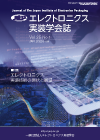Volume 25, Issue 6
Displaying 1-31 of 31 articles from this issue
- |<
- <
- 1
- >
- >|
Preface
-
Article type: Preface
2022Volume 25Issue 6 Pages P6
Published: September 01, 2022
Released on J-STAGE: September 01, 2022
Download PDF (591K)
Special Articles / Simulation Technologies of Electronics Packaging
-
Article type: Special Articles
2022Volume 25Issue 6 Pages 513
Published: September 01, 2022
Released on J-STAGE: September 01, 2022
Download PDF (638K) -
Article type: Special Articles
2022Volume 25Issue 6 Pages 514-520
Published: September 01, 2022
Released on J-STAGE: September 01, 2022
Download PDF (1543K) -
Article type: Special Articles
2022Volume 25Issue 6 Pages 521-526
Published: September 01, 2022
Released on J-STAGE: September 01, 2022
Download PDF (1712K) -
Article type: Special Articles
2022Volume 25Issue 6 Pages 527-534
Published: September 01, 2022
Released on J-STAGE: September 01, 2022
Download PDF (2025K) -
Article type: Special Articles
2022Volume 25Issue 6 Pages 535-538
Published: September 01, 2022
Released on J-STAGE: September 01, 2022
Download PDF (4003K) -
Article type: Special Articles
2022Volume 25Issue 6 Pages 539-549
Published: September 01, 2022
Released on J-STAGE: September 01, 2022
Download PDF (2705K) -
Article type: Special Articles
2022Volume 25Issue 6 Pages 549-555
Published: September 01, 2022
Released on J-STAGE: September 01, 2022
Download PDF (2371K) -
Article type: Special Articles
2022Volume 25Issue 6 Pages 556-560
Published: September 01, 2022
Released on J-STAGE: September 01, 2022
Download PDF (1246K) -
Article type: Special Articles
2022Volume 25Issue 6 Pages 561-568
Published: September 01, 2022
Released on J-STAGE: September 01, 2022
Download PDF (2295K) -
Article type: Special Articles
2022Volume 25Issue 6 Pages 569-576
Published: September 01, 2022
Released on J-STAGE: September 01, 2022
Download PDF (2093K) -
Article type: Special Articles
2022Volume 25Issue 6 Pages 577-582
Published: September 01, 2022
Released on J-STAGE: September 01, 2022
Download PDF (1329K) -
Article type: Special Articles
2022Volume 25Issue 6 Pages 583-588
Published: September 01, 2022
Released on J-STAGE: September 01, 2022
Download PDF (1567K) -
Article type: Special Articles
2022Volume 25Issue 6 Pages 589-593
Published: September 01, 2022
Released on J-STAGE: September 01, 2022
Download PDF (1754K) -
Article type: Special Articles
2022Volume 25Issue 6 Pages 594-601
Published: September 01, 2022
Released on J-STAGE: September 01, 2022
Download PDF (2469K) -
Article type: Special Articles
2022Volume 25Issue 6 Pages 602-609
Published: September 01, 2022
Released on J-STAGE: September 01, 2022
Download PDF (1920K) -
Article type: Special Articles
2022Volume 25Issue 6 Pages 610-613
Published: September 01, 2022
Released on J-STAGE: September 01, 2022
Download PDF (1351K)
2021 JIEP Award-Technical Development
-
2022Volume 25Issue 6 Pages 614-625
Published: September 01, 2022
Released on J-STAGE: September 01, 2022
Download PDF (2481K)
Technical Paper
-
Article type: Technical Paper
2022Volume 25Issue 6 Pages 626-635
Published: September 01, 2022
Released on J-STAGE: September 01, 2022
Advance online publication: June 10, 2022Download PDF (2390K) -
Article type: Technical Paper
2022Volume 25Issue 6 Pages 636-644
Published: September 01, 2022
Released on J-STAGE: September 01, 2022
Advance online publication: June 29, 2022Download PDF (2171K) -
Article type: Technical Paper
2022Volume 25Issue 6 Pages 645-651
Published: September 01, 2022
Released on J-STAGE: September 01, 2022
Advance online publication: June 28, 2022Download PDF (1584K) -
Article type: Technical Paper
2022Volume 25Issue 6 Pages 652-657
Published: September 01, 2022
Released on J-STAGE: September 01, 2022
Advance online publication: August 05, 2022Download PDF (2008K)
Report
-
Article type: Report
2022Volume 25Issue 6 Pages 658
Published: September 01, 2022
Released on J-STAGE: September 01, 2022
Download PDF (991K)
2022 JIEP Award
-
2022Volume 25Issue 6 Pages 660-671
Published: September 01, 2022
Released on J-STAGE: September 01, 2022
Download PDF (1628K)
Announcement, Contents, etc.
-
Article type: Announcement
2022Volume 25Issue 6 Pages 659
Published: September 01, 2022
Released on J-STAGE: September 01, 2022
Download PDF (668K) -
Article type: Announcement
2022Volume 25Issue 6 Pages 672-673
Published: September 01, 2022
Released on J-STAGE: September 01, 2022
Download PDF (924K) -
Article type: Announcement
2022Volume 25Issue 6 Pages 674-676
Published: September 01, 2022
Released on J-STAGE: September 01, 2022
Download PDF (813K) -
Article type: Announcement
2022Volume 25Issue 6 Pages A61-
Published: September 01, 2022
Released on J-STAGE: September 01, 2022
Download PDF (679K) -
Article type: Announcement
2022Volume 25Issue 6 Pages C61
Published: September 01, 2022
Released on J-STAGE: September 01, 2022
Download PDF (238K) -
Article type: Announcement
2022Volume 25Issue 6 Pages C62
Published: September 01, 2022
Released on J-STAGE: September 01, 2022
Download PDF (171K) -
Article type: Announcement
2022Volume 25Issue 6 Pages I61-
Published: September 01, 2022
Released on J-STAGE: September 01, 2022
Download PDF (893K)
- |<
- <
- 1
- >
- >|
